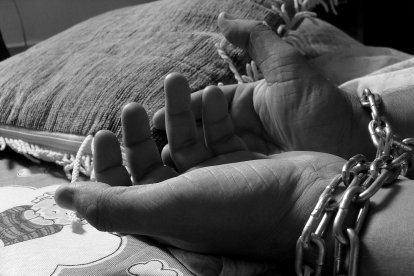Tenancingo, Mexico's "pimp town" that traffics girls to New York
It is said that in this small town in Tlaxcala, one in ten inhabitants works as a pimp, dedicating themselves to the horrible crime of human trafficking.

Imagens Evangélicas
Since the seventies Tenancingo, a small municipality located two hours by car from Mexico City, became a kind of "pimp town" where being a "padrote" is practically one of the most popular aspirations for the young people of the city.
The "padrotes" —a local term attributed to pimps—, positioned themselves in Tenancingo as the "successful men"; with the power to organize parish celebrations, influence local politics, provide employment for their criminal activities, buy luxury cars and be economically prosperous. All this is on the back of the horrible crimes involved in the recruitment of women and girls, who after being manipulated and groomed by the padrotes are sold and trafficked throughout various cities in Mexico and the United States as sex workers.
An almost ghost town
Tenancingo could be an ordinary Mexican town, with its churches, plazas and small population size. But it's not.
The city began to gain notoriety and attract international media attention in the early 2000s when the Fray Julián Garcés Human Rights Center of Tlaxcala reported the human trafficking situation in the area. From then on, the truth about this small town began to come out, little by little.
According to an extensive report by the newspaper El País, trafficking and sexual slavery are institutionalized. The statistics, although inaccurate and difficult to verify due to the covert nature of the activity, show that approximately one in ten people in the town are pimped out and a significant number of young people (at that time four out of five) saw the padrotes as their role models. This is a result of trafficking being transmitted from generation to generation through families devoted to this criminal activity, which has extended its reach to Houston, Atlanta and especially, New York.
A story of lies, corruption and invisibility
"The padrotes have developed a modus operandi of traveling to towns in poor Mexican states such as Puebla, Veracruz and Chiapas, and finding vulnerable girls. They flash their cars and jewellery and seduce them. In some cases, they spend months grooming them but in others it’s only days," writes Ioan Grillo, author of the most recent investigation on this small town in the state of Tlaxcala.
Grillo explains in his extensive article that entering Tenancingo is very complicated for outsiders since the human trafficking mafia is very well organized and has several underground locations. Lookouts along the entrance of the village are attentive to "keep watch" or give notice of strange movements in the city.
This coincides with the testimony of Irene Herrerías, the federal prosecutor in the Attorney General's Office for Crime Victim Support (Provictim) [Procuraduría de Atención a Víctimas del Delito], who in 2012 told BBC that the lookout plan was so effective that, when they arrived in town, the crime scene was cleared out.
"We have received anonymous complaints from that place, but when we tried to carry out the operation to rescue the women we found a network of lookouts who watch from a neighboring town and warn of the arrival of any outside car," Herrerías said. "When we arrived at the location there were no victims or traffickers".
Therefore, to carry out his investigation, Grillo had to remain in the shadows, without attracting attention.
While sharing his conversations with investigators in the area, the journalist explains that it is very probable that the padrotes have paid off the police, politicians and even prosecutors, generating impunity and persistent corruption in the town.
The report also notes that New York is the main destination in the United States for girls and women being trafficked from Tenancingo.
Although impunity is one of the most serious problems in Tenancingo — between 2017 and 2022, investigators in the state of Tlaxcala opened 52 files on padrotes, but only one has led to a prison sentence. In New York, dozens of sex traffickers have received harsh sentences and several victims have been rescued.
"U.S. courts have convicted more than fifty Tenancingo men for trafficking women and underage girls to sell for sex in the United States, especially New York City. Others are still at large and the town produces a startlingly high proportion of ICE’s most-wanted sex traffickers," Grillo's report reads.
Another common place where women and girls are sold again and again for sex is the famous La Merced area of Mexico City.
In either case, padrotes and traffickers pocket most of the money, as the trafficked women and girls keep none of the profits. They barely receive, mostly under duress, food and shelter.
And when you talk about girls, it's not an exaggeration.
"About a quarter of the women that police rescue from sex trafficking in Tlaxcala are under 18; in 2021, it was 11 out of 48. Furthermore, many of the adults rescued may have been recruited as teenagers," writes Grillo, who directly interviewed some of the victims. They recounted similar accounts of manipulation, blackmail and coercion to be sexually abused.
Is all lost?
While everything looks uphill for the honest families of Tenancingo, the fact that young people have lived in negative conditions and environments without values does not mean that this cannot be corrected in time.
For this reason, organizations such as Cauce Ciudadano exist, which work to prevent violence against young Mexicans and for years taught courses to the inhabitants of Tenancingo, managing to change their view of human trafficking. A practice that had been normalized.
Grillo also states in his report that there are many myths and truths about the horrific sex trafficking route that runs from Tenancingo to New York. Networks that must be demolished in order to bring down, once and for all, the mafia of the padrotes.
One of those myths writes the journalist, is that the amount of money produced by the trafficking ring in this small town of just over 11,000 inhabitants, valued at one billion dollars on some massive internet sites, is exaggerated.
Grillo explains that this is a vital point because although the padrotes are great players in their town, they are attributed with power that they do not have. They are very far from having an economic and political power like that of the big narcos, who have been brought down at times by the Mexican authorities.
In fact, for Emilio Muñoz, coordinator of the Fray Julián Garcés Human Rights Center in Tlaxcala, it is possible, through good law enforcement by the Mexican government and police, to dismantle several of the family clans dedicated to trafficking women and children in Tenancingo.
To do this, Muñoz has three key steps to combat this fearsome sex trafficking: "More prevention work teaching girls to avoid the padrotes; better support for victims; and stronger prosecutions. People need to exert pressure to make these things happen."
"Governments come and go. But we need the communities to become conscious and demand these issues are dealt with," Muñoz said.
RECOMMENDATION





















